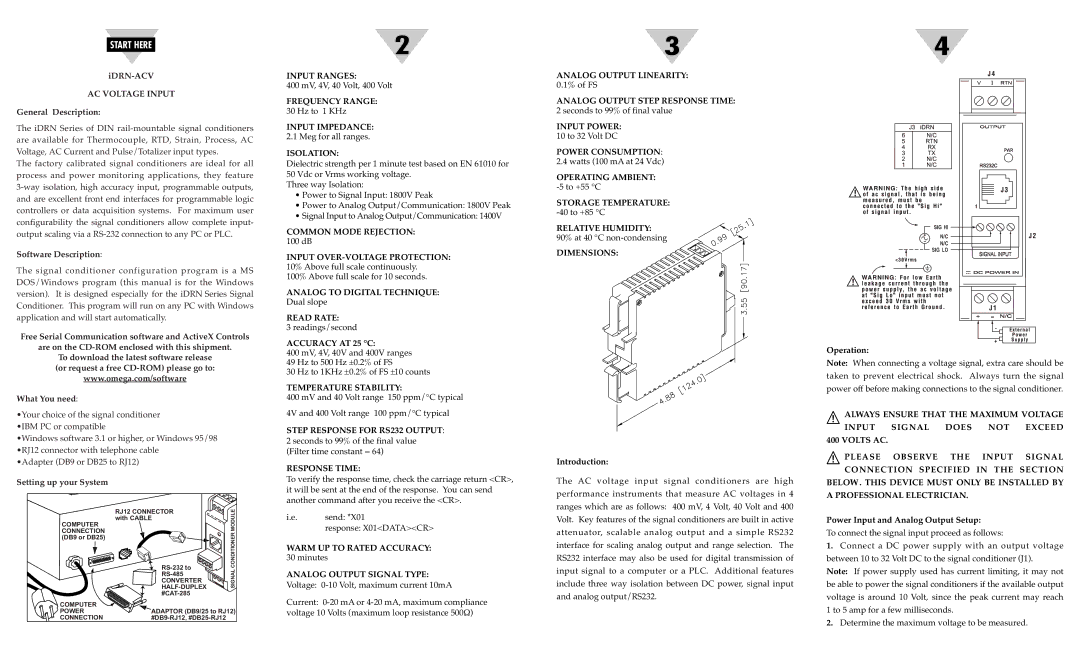
START HERE
AC VOLTAGE INPUT
General Description:
The iDRN Series of DIN
The factory calibrated signal conditioners are ideal for all process and power monitoring applications, they feature
Software Description:
The signal conditioner configuration program is a MS DOS/Windows program (this manual is for the Windows version). It is designed especially for the iDRN Series Signal Conditioner. This program will run on any PC with Windows application and will start automatically.
Free Serial Communication software and ActiveX Controls
are on the
To download the latest software release (or request a free
What You need:
•Your choice of the signal conditioner •IBM PC or compatible
•Windows software 3.1 or higher, or Windows 95/98 •RJ12 connector with telephone cable
•Adapter (DB9 or DB25 to RJ12)
Setting up your System
| RJ12 CONNECTOR | MODULE |
COMPUTER | with CABLE |
|
|
| |
CONNECTION |
| CONDITIONER |
(DB9 or DB25) |
| |
|
| |
| SIGNAL | |
| ||
| CONVERTER |
|
|
| |
|
| |
COMPUTER |
|
|
POWER | ADAPTOR (DB9/25 to RJ12) | |
CONNECTION |
| |
2
INPUT RANGES:
400 mV, 4V, 40 Volt, 400 Volt
FREQUENCY RANGE:
30 Hz to 1 KHz
INPUT IMPEDANCE:
2.1 Meg for all ranges.
ISOLATION:
Dielectric strength per 1 minute test based on EN 61010 for 50 Vdc or Vrms working voltage.
Three way Isolation:
•Power to Signal Input: 1800V Peak
•Power to Analog Output/Communication: 1800V Peak
•Signal Input to Analog Output/Communication: 1400V
COMMON MODE REJECTION: 100 dB
INPUT
100% Above full scale for 10 seconds.
ANALOG TO DIGITAL TECHNIQUE:
Dual slope
READ RATE:
3 readings/second
ACCURACY AT 25 °C:
400 mV, 4V, 40V and 400V ranges
49 Hz to 500 Hz ±0.2% of FS
30 Hz to 1KHz ±0.2% of FS ±10 counts
TEMPERATURE STABILITY:
400 mV and 40 Volt range 150 ppm/°C typical
4V and 400 Volt range 100 ppm/°C typical
STEP RESPONSE FOR RS232 OUTPUT: 2 seconds to 99% of the final value (Filter time constant = 64)
RESPONSE TIME:
To verify the response time, check the carriage return <CR>, it will be sent at the end of the response. You can send another command after you receive the <CR>.
i.e. | send: *X01 |
| response: X01<DATA><CR> |
WARM UP TO RATED ACCURACY: 30 minutes
ANALOG OUTPUT SIGNAL TYPE:
Voltage:
Current:
3
ANALOG OUTPUT LINEARITY:
0.1% of FS
ANALOG OUTPUT STEP RESPONSE TIME: 2 seconds to 99% of final value
INPUT POWER:
10 to 32 Volt DC
POWER CONSUMPTION: 2.4 watts (100 mA at 24 Vdc)
OPERATING AMBIENT:
STORAGE TEMPERATURE:
RELATIVE HUMIDITY:
90% at 40 °C
DIMENSIONS:
Introduction:
The AC voltage input signal conditioners are high performance instruments that measure AC voltages in 4 ranges which are as follows: 400 mV, 4 Volt, 40 Volt and 400 Volt. Key features of the signal conditioners are built in active attenuator, scalable analog output and a simple RS232 interface for scaling analog output and range selection. The RS232 interface may also be used for digital transmission of input signal to a computer or a PLC. Additional features include three way isolation between DC power, signal input and analog output/RS232.
4
J 4
|
| J 3 |
| SIG HI |
|
+ | N/C | J 2 |
| N/C |
|
| SIG LO |
|
J 1
Operation:
Note: When connecting a voltage signal, extra care should be taken to prevent electrical shock. Always turn the signal power off before making connections to the signal conditioner.
ALWAYS ENSURE THAT THE MAXIMUM VOLTAGE INPUT SIGNAL DOES NOT EXCEED
400 VOLTS AC.
![]() PLEASE OBSERVE THE INPUT SIGNAL CONNECTION SPECIFIED IN THE SECTION BELOW. THIS DEVICE MUST ONLY BE INSTALLED BY
PLEASE OBSERVE THE INPUT SIGNAL CONNECTION SPECIFIED IN THE SECTION BELOW. THIS DEVICE MUST ONLY BE INSTALLED BY
A PROFESSIONAL ELECTRICIAN.
Power Input and Analog Output Setup:
To connect the signal input proceed as follows:
1.Connect a DC power supply with an output voltage between 10 to 32 Volt DC to the signal conditioner (J1).
Note: If power supply used has current limiting, it may not be able to power the signal conditioners if the available output voltage is around 10 Volt, since the peak current may reach 1 to 5 amp for a few milliseconds.
2.Determine the maximum voltage to be measured.
